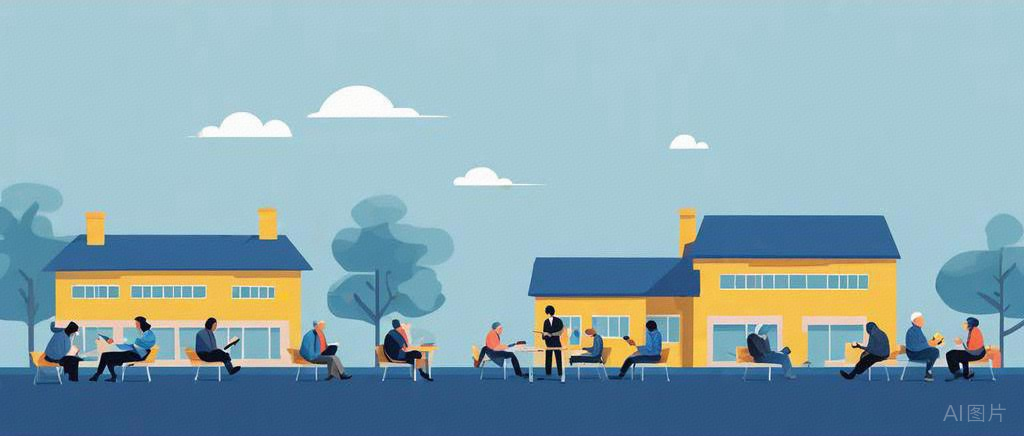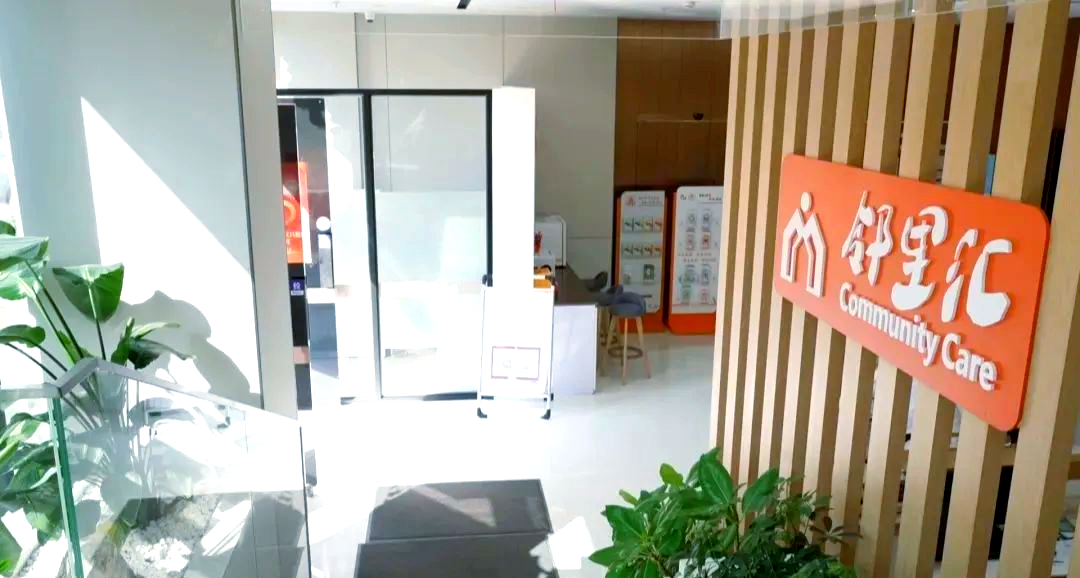

From policy dividends to practical implementation, decoding the entire industrial chain ecosystem of embedded community elderly care.
Total word count: 2208 words

Last week, I went to Xuhui District in Shanghai for research and passed by a place called“Tianlin Neighborhood Exchange,” where I saw three elderly people with canes gathered around a glass window, watching a demonstration of the “smart bathing vehicle.” This is indeed a new addition to the micro elderly care institutions embedded in the community, which can solve the bathing problem without leaving the neighborhood.
This reminded me of the latest data from the Ministry of Civil Affairs: by the end of 2024, the population aged 60 and above in China will reach 310 million, with 15.7% of them being disabled, meaning that there are over 48 million elderly people who are partially or fully disabled, and 93% of the elderly clearly state that “they do not want to leave their familiar community even in death.”.
When “institutions are too far away” and “home care is too tiring” become the pain points of elderly care, embedded community elderly care is emerging as a key to solving China’s elderly care dilemma with its “small and precise” approach.
In today’s lengthy article, we will discuss this “revolution in elderly care at your doorstep” from four dimensions: policy, market, operation, and challenges.
1. Opening the policy toolbox: How does the state support embedded elderly care with “real money”?
First, let’s look at a set of “hot and spicy” policy packages:
1. Top-level design outlines “hard indicators”

“Opinions of the Central Committee of the Communist Party of China and the State Council on Deepening the Reform and Development of Elderly Care Services” clearly proposes the model of “central station,” stipulating that new residential communities must be equipped with elderly care facilities that meet the “four synchronizations” (synchronized planning, synchronized construction, synchronized acceptance, and synchronized delivery); and to be honest, this means that in the future, every community with 500 households must at least have one embedded service station.
“Guidelines for the Construction of Community Embedded Elderly Care Institutions” set a “digital military order”: by 2025, achieve 100% coverage of county-level elderly care management platforms and 80% coverage of community embedded institutions, which means that within a 15-minute walk in every urban community, there must be a “convenience store for elderly care” that can provide care, meal assistance, and rehabilitation.
2. Financial subsidies directed at the “last mile”
Construction side: The central government provides a subsidy of 2 million yuan for each newly built embedded center, with local matching funds of no less than 30%. For example, in Beijing, a single station in Chaoyang District can receive up to 3.5 million yuan in subsidies, focusing on solving the renovation of old community spaces and the purchase of equipment.
Operation side: Subsidies are issued according to the level of disability of the elderly. In Huaibei City, mildly disabled elderly people receive a monthly subsidy of 300 yuan, while severely disabled elderly people receive 600 yuan per month; in Shanghai, subsidies are provided based on service usage, with 5 yuan for each meal assistance and 20 yuan for each rehabilitation session, directly offsetting labor costs.
By 2025, the goal is to build 5,000 community embedded centers nationwide, covering 90% of urban communities and 60% of rural towns, which means over 10 billion yuan in fiscal funds will flow into this sector each year.
3. Local pilot projects gaining “acceleration”
Shanghai’s “15-minute elderly care service circle” has covered 85% of urban areas. The Xuhui District’s “Neighborhood Exchange” model achieves “multiple functions in one exchange,” integrating meal assistance, day care, rehabilitation, and elderly-friendly renovation consultations. Government subsidies account for 40% of the institution’s revenue, and its meal assistance functions are very convenient.
Beijing’s Sanlitun Elderly Care Station successfully achieved a balance of income and expenditure through the model of “government subsidies + market-oriented operation.” When providing meal assistance to the elderly, the government sets the cost per meal at 15 yuan, while the actual cost is 20 yuan, with the difference covered by subsidies; at this time, rehabilitation therapy services are charged at an 80% discount based on market pricing, resulting in a profit margin of 5% after one year.
Shijiazhuang’s “property elderly care” pilot project has Vanke Property easily and happily provided ground-floor shops as stations for free, and the community committee actively leads and coordinates resident relations, cleverly solving the most troublesome site selection problem.
The essence of the policy is to do two things: first, lower the threshold for social capital to enter; second, leverage public resources to stimulate market-oriented services. For private elderly care institutions, this is simply a once-in-a-decade opportunity.
2. What the elderly want is not a bed, but “a dignified community life”
Research data from Anqing City is particularly worth pondering: among 157,300 elderly people in urban areas, 93.4% choose “community home care,” with their core demands ranked as follows: familiar environment (45%), convenience for children to visit (30%), and controllable costs (25%). This breaks a misconception—embedded elderly care is not a “mini nursing home,” but an “expansion of community life.”
1. Emotional value outweighs functional value
Aunt Wang from Shanghai’s Aizhaohu Elderly Care Home said: “Here, I can first go to the market to buy vegetables, then come back. At noon, I have a meal with my old friends, and in the afternoon, I sit outside to enjoy the sun. This kind of life is much freer than living in a nursing home.” Data shows that the average time elderly people spend away from home at their station is 3.2 hours per day, which is 2.5 times that of traditional institutional elderly care;
Beijing’s Shuangjing Street’s “Elderly Care Station” has set up a “Memory Corner,” displaying old sewing machines, grain tickets, and black-and-white televisions. Elderly people come here every day to “check in and reminisce,” and the frequency of psychological counseling is reduced by 60% compared to traditional institutions, which is actually the healing power of a “familiar environment.”
2. Cost advantages crush traditional models
The economic account: community day care costs 1,500-2,000 yuan per month, while full care costs 4,000-6,000 yuan, making it 30%-40% cheaper than comparable institutional elderly care, and they can return home at any time;
The time account: pilot data from Shanghai shows that embedded elderly care has increased the frequency of children visiting from 1.2 times per week in institutional care to 3.5 times, and the response time for sudden illnesses has decreased from 40 minutes to 15 minutes, which is particularly important for single-child families.
3. Service scenarios are becoming “de-institutionalized”
From “mainly care” to “service as king”: at the embedded station in Nanshan District, Shenzhen, care beds only occupy 20% of the space; and 70% of the space is used for open services—meal assistance areas serve as dining halls during the day and transform into elderly theaters at night; rehabilitation areas conduct therapy activities in the morning and become craft classrooms in the afternoon;
Innovative “respite services”: Beijing has launched a “weekend care” package where children can send elderly people to stay for 2 days when they are on business trips, charging 200 yuan per day, which includes three meals; and also provides health check-ups and entertainment activities. In 2024, the order volume for this type of service is expected to grow by 200%, easily and accurately solving the “temporary care” problem.
The essence of the elderly care needs in China is “to maintain control over life in a familiar environment.” The popularity of embedded elderly care is due to its ability to allow the elderly to enjoy the street view from their own balcony while being able to ring the community service station for a bowl of hot soup, a haircut, or a friendly chat at any time.
3. Operational practice: How can small stations create a “big ecosystem”?
After visiting more than 30 benchmark institutions, I found that successful projects are playing with the triangular model of “service resource data”:
1. Service design: from “basic version” to “customized”
Standard services (traffic layer):
Meal assistance: using the “central kitchen + community micro-station” model, a certain project in Shanghai provides an average of 200 meals per day, with a government subsidy of 5 yuan per meal, and the elderly pay 10 yuan, controlling costs at 12 yuan, relying on economies of scale to break even;
Cleaning assistance: launching a “3-hour housekeeping package,” including cleaning, laundry, and shopping for 80 yuan per time, which is 20% lower than the market price, and elderly people over 60 can use “elderly care service vouchers”;
Value-added services (profit layer):
Rehabilitation therapy: collaborating with community health service centers to introduce smart rehabilitation devices like AI gait training devices. After medical insurance reimbursement, individuals need to pay 30-50 yuan per session, and the profit margin is as high as 30%;
Age-friendly renovations: providing “light renovation” plans to install handrails, non-slip mats, and smart monitoring devices, with the government subsidizing 50% of the costs and institutions charging a 10% service fee, with a unit price of 5,000-10,000 yuan;
Emotional services (bonding layer):
Elderly learning classes: offering smartphone courses (teaching how to use health codes and make video calls), charging 50 yuan per class, and classes start with a minimum of 10 people. The classroom is used during the day and rented to community parent-child organizations at night, achieving space reuse;
Intergenerational interaction: organizing “elementary school student visiting days,” where elderly people happily teach children paper-cutting and tell stories; children also actively help elderly people shoot short videos, and this “mutual healing” activity has increased customer retention by 40%.
2. Resource integration: small institutions leverage large networks
Medical and elderly care integration “deep binding”: the model in Lixin District, Huaibei City is worth replicating. Community elderly care stations share the HIS system with Haizi Hospital, allowing blood routine and ECG data collected at the station to be directly uploaded to the hospital, with chronic disease medications delivered by the hospital pharmacy, and the medical insurance reimbursement rate is 15% higher than going to the hospital, thus achieving “minor illnesses do not leave the community, major illnesses go directly to the green path”;
Corporate cooperation “monetizing traffic”: a certain institution in Beijing has cooperated with Meituan to buy groceries, allowing elderly people to order fresh produce at the station and enjoy free delivery service, while Meituan returns 5% of the order amount as commission; additionally, this institution has developed a “community elderly care insurance” with an insurance company, where 15% of the premium is used as a service commission, and in 2023, this income accounted for 20% of total revenue.
Government resources “precise docking”: institutions in Shanghai have obtained stable cash flow by undertaking government-purchased services (such as visiting elderly people, assessing disability levels, etc.), and this type of income generally accounts for 30%-40% of their revenue.
3. Digital empowerment: small scenes accumulate big value
Smart terminals at home: providing signed elderly people with smart wristbands to easily monitor heart rate, sleep status, and detect falls, notifying family members and community doctors within 3 minutes. The device costs 200 yuan each, with government subsidies of up to 80%.
Online platform scheduling: developing WeChat mini-programs to achieve “one-click ordering + service tracking,” with a certain platform in Shanghai achieving 120,000 online orders in 2023, a year-on-year increase of 180%, and customer service costs reduced by 50%;
Data feedback to services: by analyzing the health data of 100,000 elderly people, it was found that 45% are hypertensive, so “low-salt meals” and blood pressure management courses were customized, with related service purchase rates increasing by 35%, showcasing the charm of “precise elderly care.”
4. Hidden reefs: these five pitfalls are eliminating 80% of players
The hotter the industry, the more calmly we must look at the risks. Here are some real pitfalls encountered by frontline operators:
1. NIMBY effect: from “residents’ opposition” to “breaking the ice in relationships”
In a certain central city, when preparing the station, 60% of residents expressed opposition; their reasons included “worried that elderly deaths would affect property prices” and “feeling that frequent ambulance visits are not auspicious.” The project team spent 3 months conducting community work and specifically addressing these concerns, which actually yielded some results.
Inviting residents to visit mature stations (and seeing for themselves that “there are no odors, no noise, and it actually makes the community more vibrant”;
Establishing a “resident supervision committee,” inviting enthusiastic homeowners to participate in scoring service quality, and publicly announcing the use of subsidies every month;
Opening some areas for residents to use, such as the meal assistance area being used as a community meeting hall at night, gradually alleviating mutual hostility. The experience: the primary task of embedded elderly care is not to find a site, but to “find the hearts of the people.”
2. Bed trap: from “respite services” to “long-term residence dilemma”
The originally designed short-term care ( 15-30 days) actually averages 6.8 months of stay due to the core reasons:
The elderly feel that “it is more comfortable than home and does not trouble the children”;
Family members find that “full care fees are cheaper than hiring a nanny,” so they prefer long-term custody;
Institutions, in order to maintain revenue, actively guide the elderly to stay long-term. This results in a bed turnover rate of only 32% (the ideal value is 60%), which not only contradicts the initial idea of “serving more elderly people” but also increases pressure on fire safety and nursing. The key to breaking the deadlock lies in: setting up a “3-month referral mechanism” to encourage the elderly to return home regularly, while developing a “migratory care” model (staying at the station in winter and returning to their hometown in summer).
3. Dual troubles of space and funding
Space trouble: in first-tier cities, the idle housing rent in communities is 8 yuan per square meter per day, far exceeding reasonable costs (around 5 yuan); and fire safety requirements often require a single floor to be ≥500 square meters, making 90% of community bottom shops unable to meet standards; new residential communities often have facilities built with substandard quality, for example, a project planned for 1,000 square meters of elderly care space actually delivers only 300 square meters.
Funding troubles: private elderly care institutions have an average profit margin of less than 5%. During the pandemic, 30% of stations needed to rely on founders to cover operating costs. A founder of a certain institution revealed: “The government subsidy payment cycle is quite long, reaching 6 months, but labor wages must be paid on the 15th of each month, during which time, I had to rely entirely on credit cards for cash flow.”
4. Talent shortage: post-95 caregivers with a monthly salary of 8,000 yuan are still hard to find
Data from the Beijing Elderly Care Association shows that the city has a shortage of 42,000 certified caregivers, with less than 20% being certified, and young people dislike the job as “dirty, tiring, and lacking prestige”;
Embedded institutions are relatively small and difficult to provide promotion channels, leading to situations where “newcomers leave after 3 months, and experienced workers are poached by large institutions.” A certain station in Shanghai has introduced a “partner plan” to retain staff, allowing those who work for 3 years to participate in profit sharing, resulting in a drop in turnover rate from 60% to 25%.
5. Departmental collaboration: multiple departments fail to form a synergy
The health department’s family doctor data is not open to elderly care institutions, leading to health assessments being done manually, which is very inefficient;
The medical insurance bureau excludes embedded rehabilitation projects from the reimbursement directory, requiring elderly people to pay 80 yuan for a therapy session, while it only costs 30 yuan at community health service centers, leading to customer loss;
The Ministry of Housing and Urban-Rural Development requires the construction of elderly care facilities but lacks a joint acceptance mechanism. Developers often use “planning adjustments” as an excuse to reduce the area. In fact, the civil affairs department also lacks corresponding constraints.
5. Evolution of revenue models: from “subsidy dependence” to “ecological profit”
Institutions that have survived the pain period are exploring three profit curves:
1. Basic layer: policy subsidies + service fees
The Huaibei model: construction subsidies (up to 50,000 yuan per station) + operation subsidies (600 yuan per person per month) + service fees (15 yuan per meal, 4,000 yuan per month for full care), with the three income sources accounting for 20%, 30%, and 50% respectively to achieve micro-profit;
The key formula: average monthly service income ≥3,000 yuan (covering labor + space costs) + government subsidies ≥1,500 yuan per person per month (covering equipment + consumables breakeven point).
2. Advanced layer: monetizing traffic + resource sharing
Shanghai Aizhaohu: using meal assistance to attract an average of 100 visits per day, with 35% converting to rehabilitation clients (unit price 2,000 yuan per month), and 20% converting to age-friendly renovation clients (unit price 8,000 yuan), with derived income accounting for 40%;
Cooperating with elderly products companies to set up experience areas at stations, earning a 15% commission on each wheelchair sold, with such income exceeding 500,000 yuan in 2023.
3. Future layer: data services + ecological co-construction
A certain smart elderly care platform in Beijing integrates data from 200 stations covering 100,000 elderly people (anonymized), selling it to pharmaceutical companies for chronic disease research, with a compliant price of 0.5 yuan per data point, generating 2 million yuan in annual data income, which feeds back into technology development;
Exploring “elderly care real estate” linkage to provide developers with age-friendly renovation plans, charging a service fee of 1% of the property price, thus forming a closed loop of “services feeding back into real estate, and real estate feeding back into services.”
6. The future is here: three major evolutionary directions of embedded elderly care
Standing at the node of 2024, we clearly see three trends:
1. “Micro-institution cloud platforms” become standard configuration
Each community station will have 2050 beds, focusing on short-term care and day care;
Regional smart platforms achieve “three networks in one”: service scheduling network (can dispatch on demand), health monitoring network (can provide real-time alerts), resource sharing network (can allocate equipment and personnel across stations). The Shanghai pilot has already achieved the goal of “one network for the whole city,” with emergency response times ≤3 minutes.
2. “Property elderly care” sparks a cross-industry revolution
Real estate companies like Vanke and China Resources are deeply integrating property services with elderly care services:
Using property fees to subsidize elderly care facility rents (calculated at 0.5 yuan per square meter per month);
Property staff also serve as “elderly care coordinators,” conducting daily inspections at elderly people’s doorsteps, and if any abnormalities are found, they will intervene promptly;
Developing a “property APP + elderly care module,” allowing homeowners to easily book meal assistance services with just one click; additionally, points earned from cleaning services can be exchanged for elderly care services.
3. “Time banks” activate the silver economy
The Nanjing pilot uses a “younger helping older” model where healthy elderly people aged 60-70 provide assistance and companionship to those over 80, earning 1 “time coin” for every hour of service, which can be exchanged for free haircuts, rehabilitation therapy, and other services;
It is expected that by 2025, 30% of embedded stations will introduce time bank systems, which will alleviate labor shortages while reshaping the community mutual aid ecosystem.
During my visit to Shijiazhuang, I saw a touching scene: the kitchen’s outer wall of a community embedded station was covered with handwritten “wish notes” from elderly people—”I want to learn to shoot short videos to show my grandson,” “I want to find a companion to practice Tai Chi every day,” “I want someone to teach me how to pay my water and electricity bills using my phone.”
These simple wishes constitute the core of embedded elderly care—it’s not just about piecing together rigid facilities, but rather, like capillaries, slowly permeating elderly care services into every aspect of community life.
In this way, the elderly can spend their later years with dignity in familiar streets, markets they often visit, and in a comforting dialect environment. In fact, the elderly can feel care and warmth in their daily life situations, rather than being isolated in unfamiliar and alien spaces.
When we discuss policy subsidies and revenue models, let us not forget that the essence of elderly care is actually “human services.” Those small stations hidden in community alleys may be nurturing the future of elderly care in China—allowing every elderly person to say: I am here, and I live very comfortably. This is the most touching original intention of our industry.
Interactive topic
Is there an embedded elderly care institution downstairs in your building? If your parents grow old, would you choose this kind of “elderly care at your doorstep”? Feel free to share your story in the comments, and the top 5 likes will receive an electronic version of “2025 China Silver Economy Industry Handbook.”
Source references
“Opinions of the Central Committee of the Communist Party of China and the State Council on Deepening the Reform and Development of Elderly Care Services”
“Implementation Plan for the Construction of Embedded Service Facilities in Urban Communities”
“Guidelines for the Construction of Community Embedded Elderly Care Institutions”
Interpretation of Special Policies for Elderly Care Services at the National Two Sessions in 2025
Anqing City Elderly Affairs Development Report (2023)
Shanghai Municipal Civil Affairs Bureau Embedded Elderly Care Service Case Database
China Elderly Care Industry Association “2024 Elderly Care Service Blue Book”
Beijing Elderly Care Service Industry Association Research Report
Feel free to share your views or cases in the comments!Original statement: This article is exclusively published by “Silver Age Network,” and reprinting requires authorization.More industry information
“Brand Dialogue” | Dingjia Medical | Yuanfang Boai | Gelu Tiancheng | Yutian Interactive AI |
“Industry Observation” | Elderly Care Services | Smart Elderly Care | Cultural and Recreational Travel | Age-Friendly Renovation | Third-Party Operation | Health Management | Nursing Rehabilitation | Assistive Devices | Medical Devices | Daily Household | Health and Wellness Products | Elderly Care Finance | Elderly-Related Enterprises





 Disclaimer: The articles published by this public account are for the exchange and sharing of professional knowledge and market information related to the silver economy, and are not for any commercial purposes. If any individual or organization has questions about the copyright or the authenticity and accuracy of the content of the article, please contact us immediately. We will handle it promptly.
Disclaimer: The articles published by this public account are for the exchange and sharing of professional knowledge and market information related to the silver economy, and are not for any commercial purposes. If any individual or organization has questions about the copyright or the authenticity and accuracy of the content of the article, please contact us immediately. We will handle it promptly. Like, share, and recommend, three in one 👇
Like, share, and recommend, three in one 👇